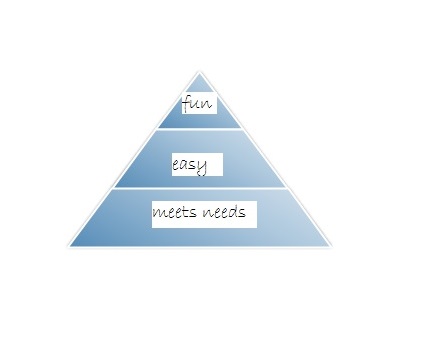In their intriguing and practical book, Outside In: The Power of Putting Customers at the Center of Your Business, Harley Manning and Kerry Bodine of Forrester Research share an extremely simple and sensible diagram called “The Customer Experience Pyramid.” This was first developed by Dr. Elizabeth B. N. Sanders.
The concept is that people initially care about whether a product or service meets their needs. If not, they don’t consider how easy it is.
If their needs are met, then they want it to be easy. If it’s not — and if there is an alternative which meets their needs and which is also easy — then they will go elsewhere.
If there’s a place that meets their needs and is easy and it’s also enjoyable, people will choose that option.
In our business, it’s easy to see how this is relevant. Lots of people, unfortunately, have the experience of hiring a company to build their website and having, in six weeks or so, no website. Or perhaps a website of sorts, but one which has empty pages or in some other way is not actually finished and meeting their or their visitors’ needs.
Many people also find, whether they get a finished website or not, that the process is difficult. We talk with a lot of people who have tried a DIY website building option of some kind and have found that it wasn’t as easy as they had expected. We’ve also talked with people who have hired a company and then found that they couldn’t get hold of the company, their calls weren’t returned, they were expected to provide things they can’t get, and all explanations seem to be in a foreign language.
That’s not how it should be. And we have to recognize that clients who have spent months or years working hard and have ended up with a nonfunctional website will not have had fun, whether they liked the web designers or not.
Your industry may or may not have a similar story. Auto mechanic? Yes, you can probably relate. Restaurant? Probably not. Correct me if I’m wrong.
Think about your website, though.
The Customer Experience Pyramid tells us that it doesn’t matter if your colors are bright and cheery and you have cool graphics — if your visitors can’t find your contact information or your checkout process doesn’t work.
Start with the basics: what are your visitors trying to do? Can they accomplish that?
Next, see if you can make it easy. Do you have to have Captchas? Must your visitors click five times to find your map? Could you have an online patient form instead of something that people have to download and print?
Only when things actually work should you focus on the fun. Enjoyable is good, but not if your needs aren’t met.
We would say that having a findable website belongs on the bottom of the pyramid. If you can’t find a company’s website when you look for them online, that website doesn’t work. If later they give you the URL and you discover that they have a delightful website, it may or may not make up for your initial perception that their website doesn’t work.
Bottom line: your website must be findable and usable to be successful. No matter what color it is.


Leave a Reply